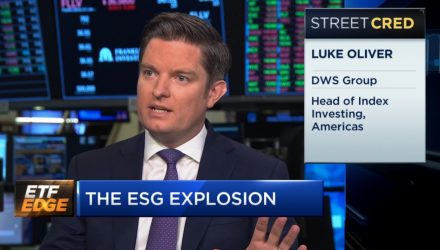During CNBC’s “ETF Edge” segment on Monday, host Bob Pisani explored more of what Environmental, Social, and Governance (ESG) represents. It involves looking for companies meeting positive standards or corporate responsibility, but there was more to look into during the segment, with help from Luke Oliver, Head of Index Investing, Americas, at DWS.
As DWS has its own suite of ESG ETFs, Oliver was able to add to the conversation concerning environmental and socially responsible ETFs involving various companies. Speaking to the actual interest out there, Oliver notes how it’s even more prevalent in Europe.
“Currently, there’s about 124 billion tracking ESG strategies in Europe, ETFs in fact. And in the US, we have 50 ESG products tracking about 12 billion, which has doubled over the last year or so. So, certainly some momentum behind it,” Oliver notes.
How To ‘Sell’ ESG Investing
As far as how to sell it, Oliver explains how it’s not a matter of having a theme on a particular element of ESG. Instead, ESG products are looking across all sectors to find a good, investable product that can work as a core strategy. The ideal would be something allowing for a light return to the market, a light risk, and core pricing, which has been the turn-off for many people in the past.
Pisani then wonders why, even as a $4 trillion business, it still seems so small, despite the seemingly prevalent strong belief in social responsibility. Fortunately, ETF Trends’ CEO Tom Lydon was on hand to add his thoughts.
“I think it’s going to get traction,” Lydon remarks. “There’s a huge amount of following over in Europe. We have a generation that’s growing up right now, that is really adamant about sticking with this type of investing. And going forward, we’re going to make sure, and I think collectively in the ETF space is all going to be a part of it, that if you are not sticking to these standards…it’s all about education, and we’re just getting started.”
When asked if ESG is going to make a difference long-term in moving the needle on corporate behavior, Oliver responds, “Absolutely.” From his perspective, there’s a transfer of wealth to the millennial generation that shows 90% expect to invest through this type of socially aware responsibility. That trend, accompanied with the $30 trillion being shifted over the next 20 years, really means companies are going to have to take notice.
That said, as Oliver explains, “There’s a key misconception that people are falling into, that ESG means you’re stepping away from performance, and making some activist play when in fact, what ESG is all about, as you said, is companies that are responsible with their supply chains and their employees, companies that have good governance, and responsible uses of renewable energies.”
As Oliver makes clear, these are not activist sentiments. These are suitable, stable investments for the way the world’s developing.
A Closer Look At USSG
Looking at the Xtrackers MSCI USA ESG Leaders Equity ETF (USSG), it has tracked the S&P closely this year. Its top holdings are Microsoft (MSFT), Alphabet (GOOGL), Johnson & Johnson (JNJ), and Visa (V). These are notably all large-cap names.
Pisani then asks what is it that has these companies meeting the standards for ESG. Oliver explains how the idea with USSG, among other DWS ETFs, is to provide a performance like the S&P while being aware of the ESG.
More interesting is how some energy companies still make it into these benchmarks. One would think an energy company could potentially be bad for the environment. However, they spend more than most on renewable energy.
When asked about Exxon Mobile (NYSE: XOM), Oliver explains how it fits criteria by matching an argument about having energy in a portfolio and being the energy company that scores better when it comes to closing in on the ideals of ESG. This does mean screening some out, but the goal is to keep some energy companies for the sake of at least being neutral to that sector.
Related: Due Diligence Necessary When It Comes To ESG Funds
Speaking about the costs, Oliver confirms how ESG ETFs are relatively low-cost. “11 and 10 basis points,” Oliver states.
It’s competitive with the S&P, and CFRA’s Todd Rosenbluth adds, “That’s what’s going to help people come in the door. So, people have historically thought that it was a premium product in ESG. But now the costs have come down, and they’re more likely to come and take a look at the product.”
Regardless of why ESG hasn’t sold as much as was perhaps expected, there is a confidence from this group, suggesting things will have a significant turnaround in the years to come.
As Oliver concludes, “We’ve launched two ETFs this year, and we’ve raised $1.5 billion in them, so I think we’re starting to see that momentum.”
Watch This Discussion Over ESG:
For more market trends, visit ETF Trends.
